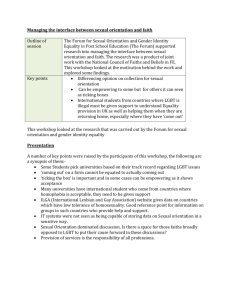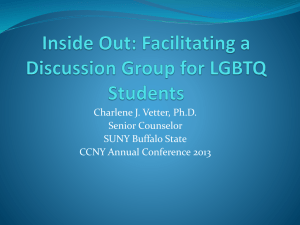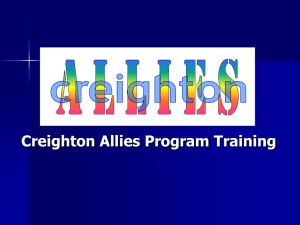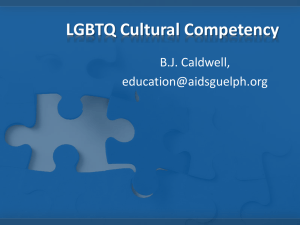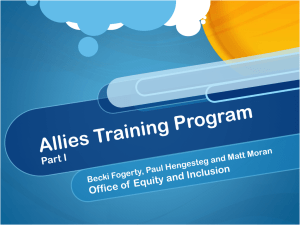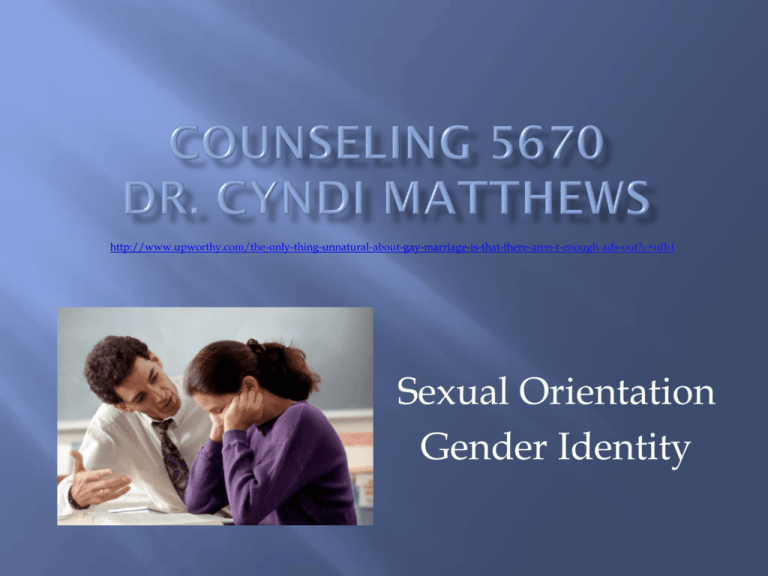
http://www.upworthy.com/the-only-thing-unnatural-about-gay-marriage-is-that-there-aren-t-enough-ads-out?c=ufb1
Sexual Orientation
Gender Identity
Broken Beer Bottle
Chipped Tooth
Lost files of a reported
stalking incident
Bag of dog poop
When was the first time you remember
knowing there is a sexual orientation
other than heterosexual and what do you
remember learning about LGBT people?
What representations of LGBT people do
you see today?
Are they positive or negative?
What is one LGBT topic you are
interested in learning more about and
what are ways to seek out information?
•What if you don’t want to counsel an LGBT individual?
• What does the Hermann/Herlihy article tell us?
• What about ACA/APA ethical guidelines?
28 % students drop out of school because
they feel unsupported
80% of anti-gay violence goes unreported
5x more likely to commit suicide
7x more likely to be a victim of a hate crime
90% report being bullied during
school/college
40% report being physically harassed
because of their sexual orientation
26x a day LGBTQ hear anti-gay slurs
82% reported faculty/staff never intervened
when slurs were made
75% of people committing hate crimes are
under 30 – majority are in school/college
environment
GPA for LGBTQ students who can identify
supportive staff/faculty: 3.1
GPA for LGBTQ students who cannot
identify supportive staff/faculty: 2.8
Suicide
47% have attempted
27% have attempted more
than once
37% have seriously thought
about suicide in last 12
months
• Family Life
85% have come out to family
19% do not feel safe coming
out to family
42% abused by family member
26% kicked out due to sexual
identity
• Sexual Behavior
16% have survival sex
43% have been forced to have sex
50% do not use protection
40% have never been tested for
STDs (10% know have STD)
• Coping Methods
35% smoke
90% use alcohol
29% use pot
30% use cocaine
22% use heroine
17% been to rehab
38% start fights
36% cutting
43% eating disord.
53% therapy
-for depression
& anxiety
Attitudes Towards clients
6 Guidelines
Previous beliefs in the profession about sexuality and mental
illness
Few differences in LGBT persons and heterosexual persons in
matters of psychological functioning.
What differences were found were attributed to social stigma of
sexuality as opposed to intrinsic qualities of said persons.
Seek consultation and training if indicated.
Key issues to receive training in:
Understanding of human sexuality
The “Coming Out’ Process and it’s effect on clients
Same Sex Relationship Dynamics
Family of Origin Issues
Spirituality issues that interact with sexuality decisions.
Career Issues/Discrimination
Coping Strategies for Healthy Living
Realize prejudice, discrimination, violence poses risks to mental
health
Sexual Minority Orientation in a heteronormative society can cause persons
to be at risk for greater stress from daily stresses and major events related to
sexual orientation.
Negative attitudes about sexual orientation may have been internalized.
It is recommended that psychotherapists take an accurate and complete
history to assesses for past victimization that may be related to sexual
orientation.
Psychotherapist must base treatment on accurate understanding of
issues related to sexual orientation.
(e.g. a psychotherapist providing information about sexual orientation &
mental health; a psychotherapist debunking myths regarding
heteronormativity and reparation therapy)
Related to Romantic Partners
communication
difficulties, sexual problems
dual-career issues, household chores
commitment decisions, marriage discrimination, family
Parenting
Child custody
LGBT parents (myths)
Guideline 6: Relationships
and Families
• Guideline 6: Psychologists strive to understand
the particular circumstances and challenges
faced by lesbian, gay, and bisexual parents.
– Legal/Social Welfare institutions have discriminated
against LGBT parents and raised concern about their
influence on a child's gender identity, gender role
conformity, and sexual orientation.
– Currently no data exists that supports differences in
children on LGBT parents and children of
heterosexual parents in regard to gender identity,
gender role conformity, or sexual orientation.
– Marriage rights/Hospital rights/Insurance
Rigid
gender-based roles unhealthier
Limits relationships with
members of one’s own gender
Disrupts family relationships and
communication
Inhibits some LGBT people from
developing an authentic selfidentity, causing undue stress
Pressure to be heterosexually
active to prove they are normal
Stigmatizes and targets
people who are perceived to
be LGBT
Denies the benefits and gifts
LGBT have to offer
Diverts energy away from
more constructive endeavors
Encourages bias for everyone
Discourages diversity
Sexual Orientation
LGBTQQIAAP
Gender
Identity/Gender
Expression
Transgender,
Transvestite,
Transsexual
Please write YOUR definition of the word(s) your group
has been given.
We will then discuss as a group and come to shared
definitions.
Sexual orientation is a pattern of
emotional, romantic, and/or sexual
attractions to men, women, or both sexes.
Recent data and research estimates
indicate that 3.5% - 10% of the population
identifies as lesbian, gay, bisexual, or
transgender.
The visibility of LGBTQ individuals as a
group is higher than ever.
Biological Sex (genitals, hormones, chromosomes)
Male
Intersex
(Hermaphrodite)
Female
Sexual Orientation (Kinsey Scale)
0
3
6
Straight
Bisexual
Gay/Lesbian
(others include: Asexual, pansexual)
Gender (socially constructed) and Gender Expression
Masculine
Androgynous
Feminine
What is Heterosexual Privilege? Examples?
Heterosexual Questions - Microaggressions
Heterosexual Privilege
What is homophobia? Biphobia? Transphobia
What is internalized homophobia?
Thinking of an LGBTQ’s sexuality or gender
identity rather than seeing them as a whole
person
Assuming a bisexual person is experimenting
with a gay or lesbian relationship
Changing your seat in a meeting if LGBTQ
person sits next to you
Thinking you can “spot one”
Worrying about the effect LGBTQ
person might have on your work
environment or school
Thinking that if a LGBTQ person touches you – they
are making an advance
Stereotyping lesbians as man-haters and gay men as
sissies
Feeling repulsed by displays of affection between
LGBTQ individuals
Wondering which one in the pair is the “man” or
“woman”
Assuming everyone you meet is probably heterosexual
Being outspoken about queer rights, but making sure
everyone knows you are straight
The American Psychiatric Association classified
“homosexuality” as a mental illness until 1973.
The American Psychological Association took
“homosexuality” out of the Diagnostic
Statistician’s Manual (DSM) in 1973
The American Psychiatric Association, The
American Psychological Association, and the
American Counseling Association deem it
unethical to practice “reparative” therapy
(increased depression, suicide)
ACA code of ethics states what?
Nature/Heredity
Environmental
Factors
Does it Matter?
http://www.youtube.com/watch?v
=MfBOGXFkC8c
There are differing opinions on the
causes of being LGBT – most
theories support Nature/Heredity
Book: Is It a Choice?
Heterosexual Questionnaire
Nature/Heredity
Environmental
Factors
Does it Matter?
Lifelong process – stages of development (Cass, 1979)
1. Identity Confusion (feeling different)
2 Identity Comparison
3. Identity Tolerance (find support groups)
4. Identity Acceptance (Coming Out)
4. Pride Development
5. Synthesis
Ongoing – not always one direction
Different for different people
Fear of being “outed”
Why do people stay “in the closet?”
What can you do if someone comes out to you?
What might one say in each stage?
Homophobia
Biphobia
Transphobia
How can phobias be
internalized?
Thinking of an LGBTQ’s sexuality or gender
identity rather than seeing them as a whole
person
Assuming a bisexual person is experimenting
with a gay or lesbian relationship
Changing your seat in a meeting if LGBTQ
person sits next to you
Thinking you can “spot one”
Worrying about the effect LGBTQ
person might have on your work
environment or school
Thinking that if a LGBTQ person touches you –
they are making an advance
Stereotyping lesbians as man-haters and gay men
as sissies
Feeling repulsed by displays of affection between
LGBTQ individuals
Wondering which one in the pair is the “man” or
“woman”
Assuming everyone you meet is probably
heterosexual
Being outspoken about queer rights, but making
sure everyone knows you are straight
Repulsion
Pity
Tolerance
Acceptance
Support
Admiration
Appreciation
Nurturance
Fill out the form first
for yourself under
“YOU” for things
which you deserve
Now fill it out for
what you think
everyone else
deserves
Is there a difference?
Ethics
Non-maleficence
Do no harm
Unconditional
Positive Regard
Do Good
Respect for
Autonomy
Beneficence
Counseling
Individual Rights
Justice: Fairness
Fidelity: Keep your
word
Veracity: Truth
Respect
Not judging
Empathy (not
sympathy)
Genuineness &
Congruence
General Systems Model
INPUTS
P
R
O
C
E
S
S
E
S
OUTPUTS
FEEDBACK
An Integrative Model for Counselors Helping LGB Youth
Through the Coming-Out Process
Counselor Strategies
and Interventions
Internal Factors:
Sexual-Identity Stage
Internalized Feelings of
Homophobia
Self Esteem/Acceptance
Mental Health Behaviors
External Factors
Family Environment
School/Peer Environment
Access to LGB Support
Network
Race/Culture
Religion
Previous Counseling
Experience
Addressing Personal Homophobia
Openly Accepting and Being Supportive
of LGB youth
Getting Training re: LGB Issues;
i.e., knowing stages of development
Working With Parents As Needed –
educating, conflict management, etc.
Addressing family issues, peer
issues, school environment,
Addressing religious issues/beliefs
Addressing issues of race/culture
Addressing previous counseling exp.
Providing Resources (i.e., literature and
support groups)
Specific Techniques: Role Playing,
Reframing issues
Social Advocacy/Policy Changes
Client Outputs
Coming Out Process
Client Inputs
Self Esteem/
Self Acceptance
Mental Health
Behaviors
Family Support
Peer Support
LGB Community
Support
Institution Support
Religion/Schools
Gender Identity
Acceptance/Integration
Continued Support as Needed
Sexual-Identity Stage
Religion
Helps Counselor Determine
Interventions/Strategies
Race/Culture
*Identity Confusion
*Identity Comparison
*Identity Tolerance
*Identity Acceptance (disc)
*Identity Pride
*Identity Synthesis
Access to LGB
Support Network
*Cass (1984)
Internalized
Feelings of
Homophobia
Self Esteem &
Acceptance
Mental Health
Behaviors
School/Peer
Environment
Family
Environment
Previous Counseling
Experience
Key:
Internal Factors
External Factors
Counselor Strategies
and Interventions:
Getting Training re: LGB Issues;
i.e., knowing stages of development
Addressing Personal Homophobia
Openly Accepting and Being Supportive
of LGB youth
Working With Parents As Needed –
educating, conflict management, etc.
Addressing family issues, peer
issues, school environment,
Addressing religious issues/beliefs
Addressing issues of race/culture
Addressing previous counseling experience
Providing Resources (i.e., literature and
support groups)
Specific Techniques: Role Playing,
Reframing issues
Social Advocacy/
Policy Changes
Coming Out Process
Client Outputs
Self Esteem/
Self Acceptance
Mental Health
Behaviors
Family Support
Peer Support
LGB Community
Support
Institution Support
Religion/Schools
Gender Identity
Acceptance/Integration
Continued Support
as Needed
•
•
•
•
•
•
Jerry: A Case Study
17 year old
Hispanic
Catholic
Gay Male
Working 3 part time jobs
Quit school at 16 due to
being bullied
• Attends a weekly GLBT
youth support group
• Referred to counseling for
depression and anger issues
• Previous Counseling
experience (x2)
Sexual-Identity Stage
Religion
Helps Counselor Determine
Interventions/Strategies
Race/Culture
*Identity Confusion
*Identity Comparison
*Identity Tolerance
*Identity Acceptance (disc)
*Identity Pride
*Identity Synthesis
Access to LGB
Support Network
*Cass (1984)
Internalized
Feelings of
Homophobia
Self Esteem &
Acceptance
Mental Health
Behaviors
School/Peer
Environment
Family
Environment
Previous Counseling
Experience
Key:
Internal Factors
External Factors
Internal Factors
External Factors
Religion
*raised Catholic
*told he is evil
*Wicca
Sexual-Identity Stage
*Identity
Tolerance/Identity
Acceptance
Has Internalized
Feelings of
Homophobia/Anger
Self Esteem &
Acceptance Low
Race/Culture
*Hispanic
*looked down upon
Access to GLBT
Support Network
*GLBT youth group
weekly meetings
*Family meetings
Previous Counseling
Experience
*2 different counselors
*”Reparative therapy”
Mental Health Behaviors
*cutting
*suicide attempts
*drug & alcohol attempts
*journalizing
*meditation
Family Environment
*Feels mother, brother and
sister-in-law won’t be
supportive because of
religious beliefs
Psycho-educational regarding stages –
Normalizing Feelings
Addressing Personal Homophobia
Addressing religious issues/beliefs –
finding common church for family/himself
Wicca practices
Specific Techniques: Role Playing,
Reframing issues (e.g. anger management)
Openly Accepting and Being Supportive
of GLBT youth
Working With Parents As Needed –
educating, conflict management, etc.
Addressing issues of race/culture
Mental Health Behaviors: meditation,
music, journaling
Continued Support
as Needed
Coming Out Process
Counselor Strategies
and Interventions
Counselor Strategies
and Interventions:
Getting Training re: LGB Issues;
i.e., knowing stages of development
Addressing Personal Homophobia
Openly Accepting and Being Supportive
of LGB youth
Working With Parents As Needed –
educating, conflict management, etc.
Addressing family issues, peer
issues, school environment,
Addressing religious issues/beliefs
Addressing issues of race/culture
Addressing previous counseling experience
Providing Resources (i.e., literature and
support groups)
Specific Techniques: Role Playing,
Reframing issues
Social Advocacy/
Policy Changes
What are some potential biases a counselor
needs to be aware of within her or himself
when working with a LGBT client?
Identify inappropriate reactions a counselor
may have when finding that his or her client is
a sexual minority.
Drawing from the Matthews/Salazar article,
what are some key issues faced by LGBT
individuals?
What can counselors do to alleviate some of
these issues faced by sexual minorities?
PFLAG
Gay/Straight alliances (GSA’s) – High School
www.glsen.org
Safe Zone/Safe Spaces) - Universities
ALGBTIC; TALGBTIC through ACA and TCA
www.gsanetwork.org
GLSEN: Gay, lesbian and straight education
network
www.pflag.org
www.algbtic.org
www.txca.org/tca/TALGBTIC_Home.asp
Churches/Church Leaders (Cathedral of Hope)
Lenses Book
Chapter 9 Sarah P. 277
What are the issues to be considered?
How would you work with Sarah?
Chapter 10 Jeff P. 310
What factors would you take into consideration?
How would you work with Jeff?

